Reproduction of roses: methods and secrets
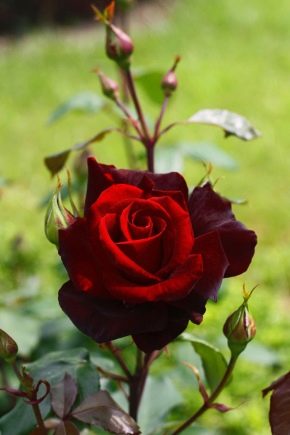
Rose is a flower that has enjoyed immense popularity in all countries at all times. A beautiful plant leaves few people indifferent, it is not for nothing that it is associated with female beauty. There are technologies that make it possible to grow these wonderful plants both in greenhouses and at home without much difficulty.
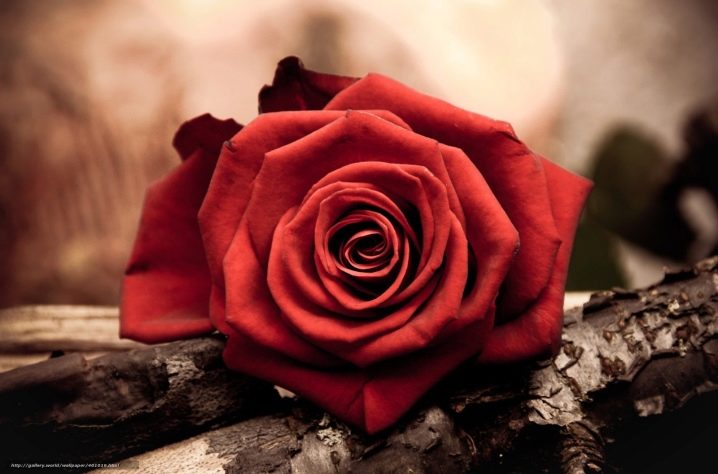
Better ways
The most popular way to propagate roses is by growing flowers from cuttings. The technology is quite simple and does not require large investments. There are several advantages to grafting over the grafting method. Advantages of the graft method:
- plants form a strong root system;
- flowers can withstand negative temperatures and high humidity;
- good plant resistance contributes to their rapid recovery;
- to bring out a new plant, it is enough to "borrow" a twig from a bouquet;
- caring for roses during cultivation does not take much time.
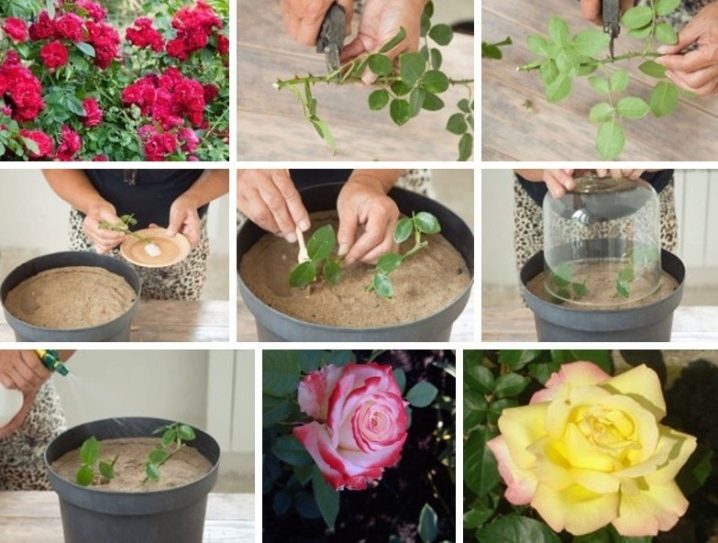
Reproduction of roses by cuttings in the fall is the simplest and most common method; cuttings of roses usually occur shortly before the onset of the winter cold.
In this case, there are many useful offshoots that can be used with benefit.
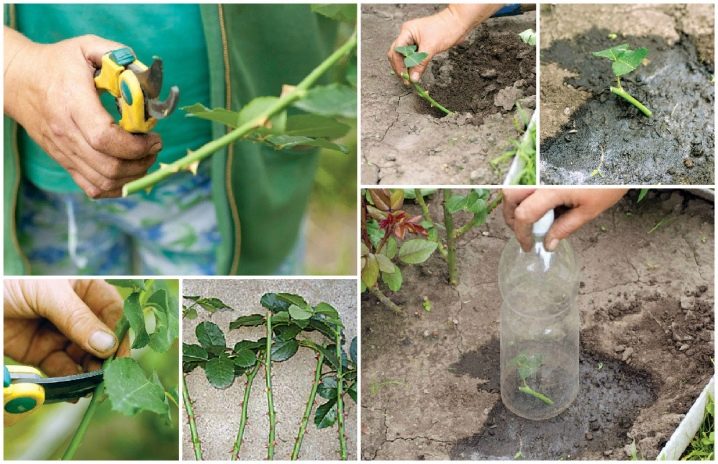
Some people prefer to carry out the rooting process in early August in a private household, this method also allows most plants to take root.
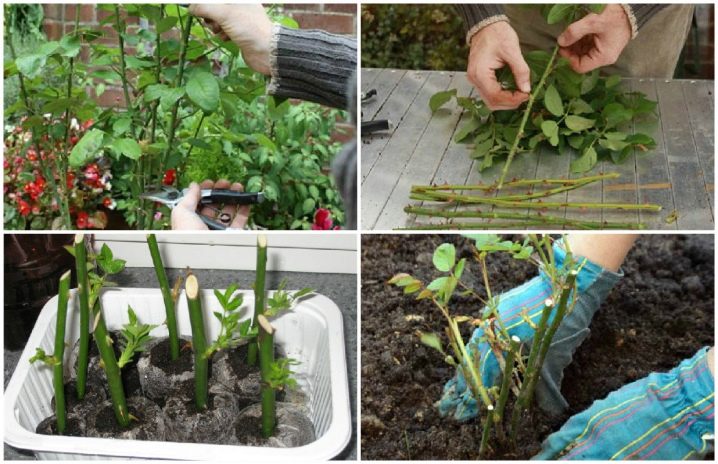
Cutting is followed by pruning, which is carried out during the period of the appearance of the first night frosts. In central Russia, this usually happens in late October, early November. Plants with a thickness of about 5 mm are ideal for cuttings. It is not difficult to determine the suitability of a plant by its appearance: if you press the thorns, they will easily bounce off. Each plant has several buds (up to four), the length is about twenty centimeters.
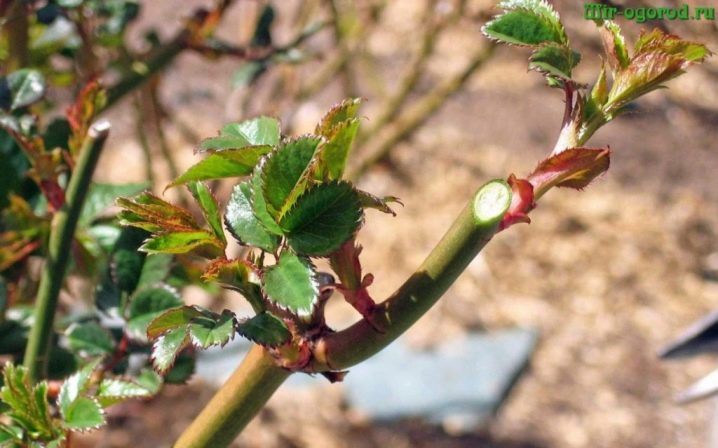
It is also important to plant the plant with the right end, so that there is no “vice versa”. At the top, an indent is made a couple of centimeters, a straight cut is made, a little lower, another cut is made - oblique, at an angle of 40 degrees.
It is recommended to use a very sharp knife or tweezers, they should be wiped with alcohol before the "operation".
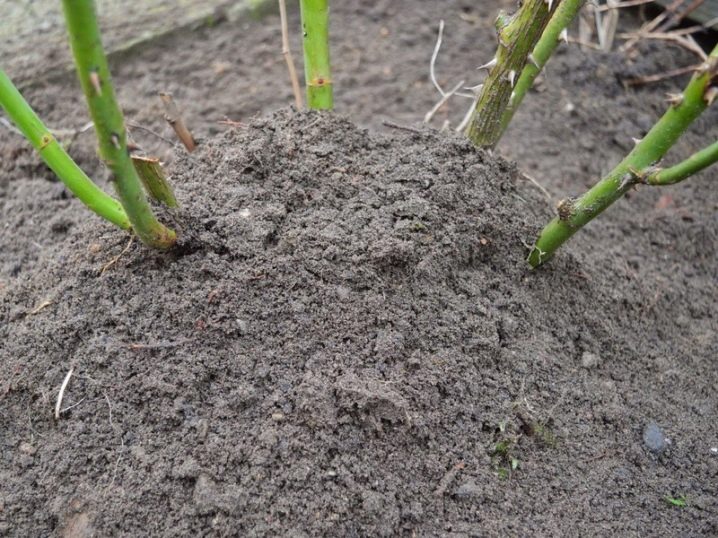
Every farmer and gardener is well aware of the existence of shrub plants that can be propagated using a very simple technology: a young sprout is dug in, watered, and after a short time it germinates.

The following types are ideal for growing roses:
- climbing;
- miniature.
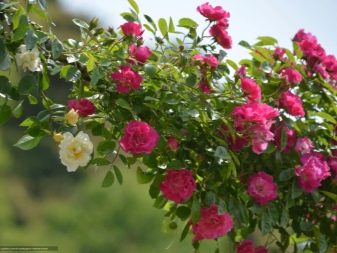
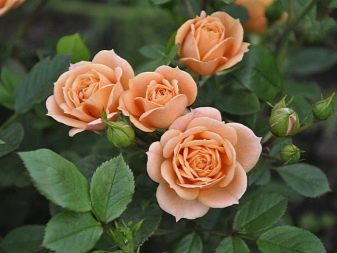
Other varieties of these beautiful flowers (hybrid tea or floribunda) have branches that are stiff by the time they can be propagated. With layering, this can be done quite simply. However, each species behaves differently, this postulate also has a direct bearing on cuttings. To plant a flexible shoot, it can simply be placed in the ground. It should only be freed from the leaves, leaving 1-2 internodes at the end. A small groove is dug in the soil along its entire length, it is watered moderately.

If the roses are already grafted, then it is not recommended to propagate with vertical layers. This is explained by the fact that the shoots grow on the cut bush. Only self-rooted varieties reproduce by vertical layering, which tolerate all pruning operations well.
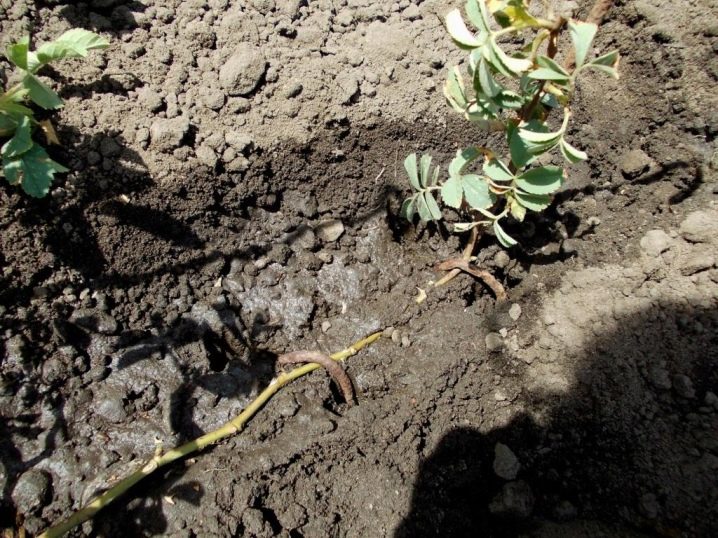
Before the beginning of winter, rose bushes are cut, leaving shoots no more than ten centimeters in size. In March, these "hemp" are sprinkled with soil.
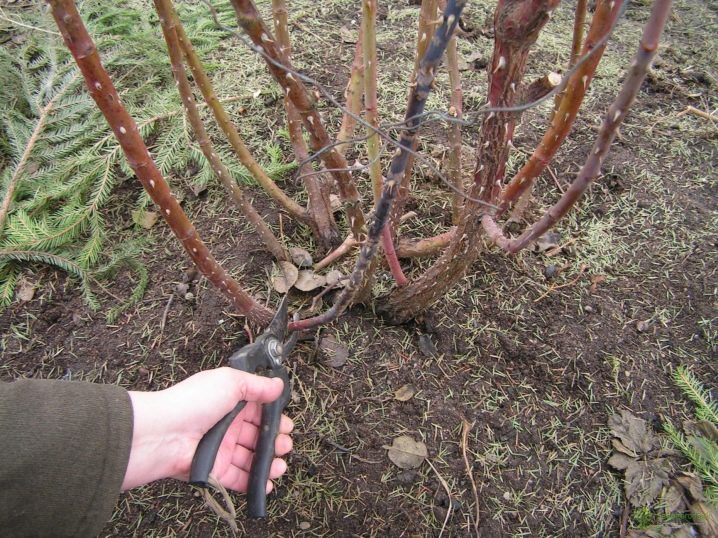
To improve the stock, vertical layers are often used, they gradually germinate, then it is recommended to add soil so that the mound grows up to 30 cm high.
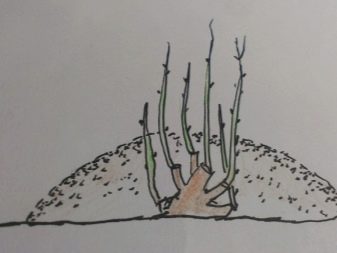
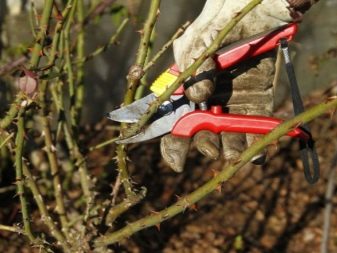
Shortly before the cold weather, the soil is carefully removed, while it is important not to touch the delicate roots. The shoots are separated from the bush and installed in pots, then they can be "brought to mind" there. Each method has its own advantages, this technology allows plants to survive and not die for one reason or another.
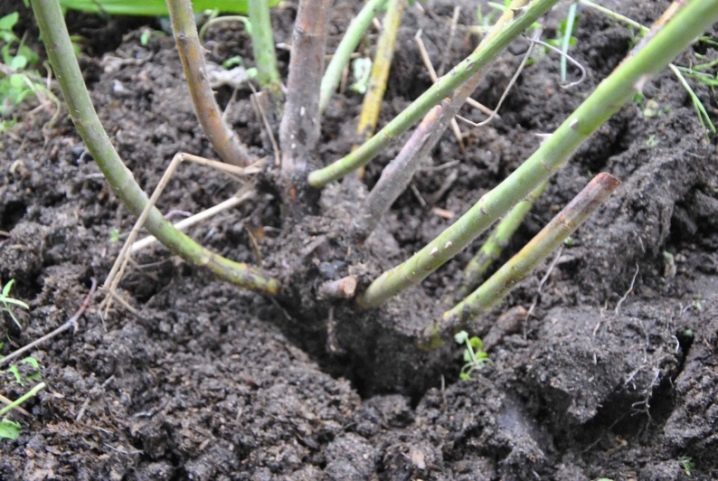
The indisputable advantage of each method guarantees the preservation of the rose variety. And also attracted by the simplicity of laying layering in the ground. The disadvantage of air and vertical layering is that these methods are quite laborious, they require attention and high qualifications. Such work can only be carried out with some varieties of roses.
The most popular and simplest method is to install the shoots in the ground. The technology works according to the following algorithm:
- mark the landing site;
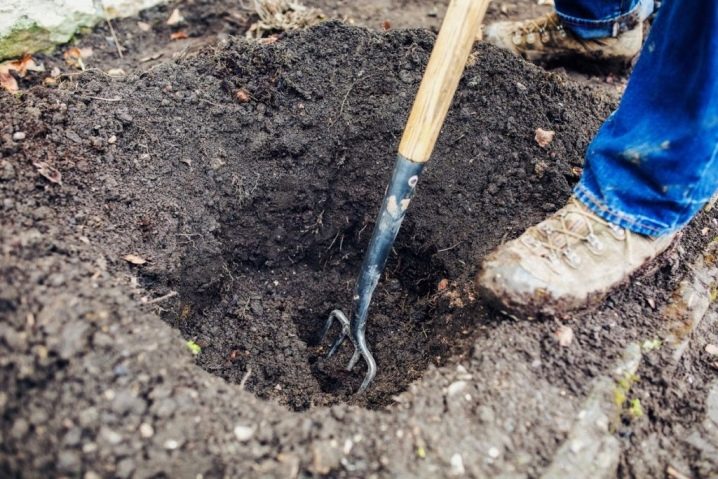
- a site for planting and nutritional composition (peat, phosphorus additives) is being prepared;
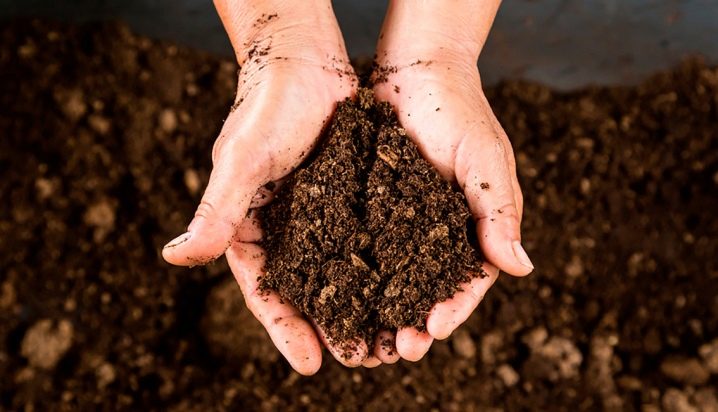
- the sprout itself is examined and prepared, placed in the groove;

- a young plant is fixed with special pins or pegs;

- sprinkle with soil, watered.
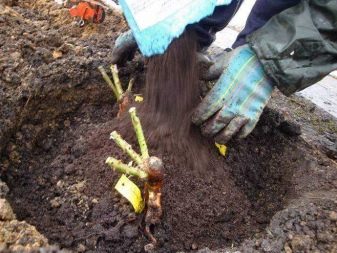

During the warm season, the plant is watered moderately, the soil should not dry out. In September-October, the cuttings are separated from the main plant and transplanted to a stationary place. Cuttings on roses can be processed in almost any warm month from March to November, but the spring time is considered the most favorable for such work. In autumn, the shoots can be separated and transplanted; it is permissible to grow them in a pot at home.
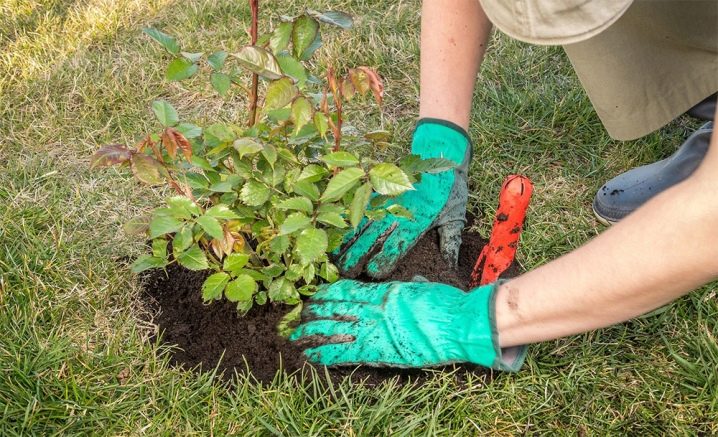
Work with air layers takes place in the warm season, after removing them, they can be "grown" in a room with a high above zero temperature, this makes it possible for the sprouts to strengthen. Reproduction by layering has a number of advantages:
- plants retain all their protective qualities, they are able to continue to develop well;
- cuttings rooted in the ground develop better, which means that rose bushes never transform into rose hips;
- the cuttings are more resilient and the survival rate is higher than with cuttings.
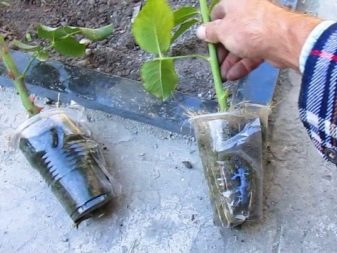
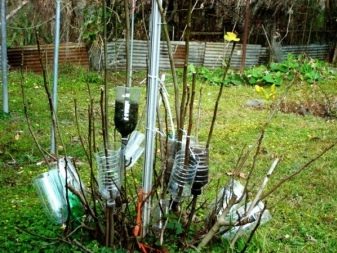
The disadvantage of this technology is that it is applicable only to climbing and miniature roses.
A small container is required to germinate miniature roses. Layering technology is quite applicable for this variety of roses. It is very important to find a long shoot at the very beginning, it can be dug in a separate container. The work takes place according to a certain algorithm.
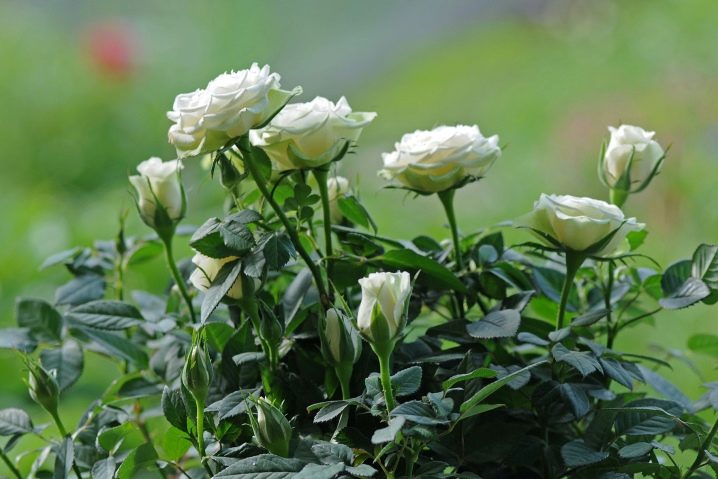
First of all, all leaves are removed from the young plant. Only at the very edge remains a small amount.
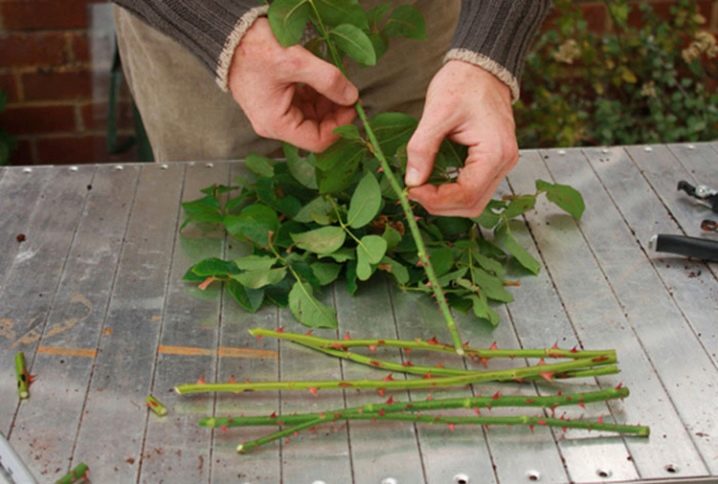
There is a kidney, which will be installed in the ground, a small incision should be made under it with a knife, then the area is treated with a stimulant, which is intended for root formation.
A special composition, a substrate is placed in a separate container, the plant is added with the end down. Watering. The plant should germinate in a moderately humid environment. After the plant has taken root, the cut is cut from the mother plant, it can be grown independently.
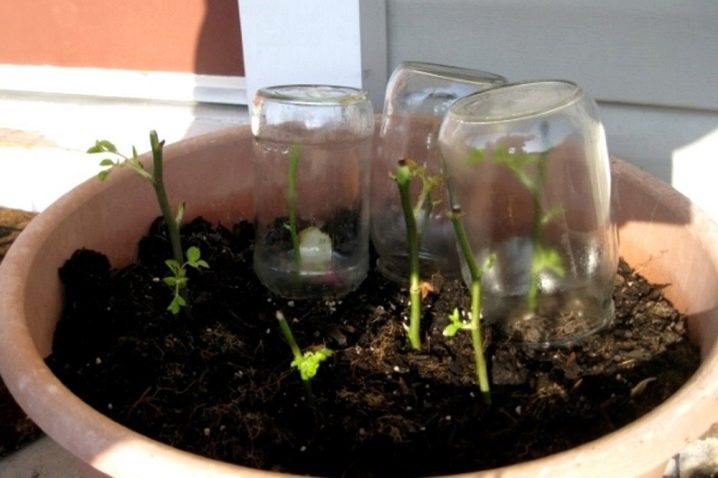
Mineral compositions with which it is allowed to process plants:
- superphosphate - added in the amount of 21 g / m2;
- potassium chloride - can be added in the amount of 11 g / m2;
- often, instead of chemical additives, use ash, which is distributed at the rate of 315 grams per 1 square meter.
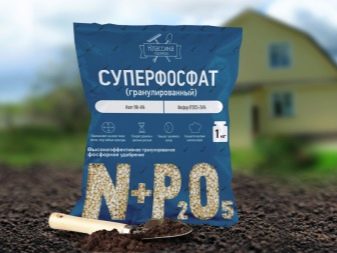
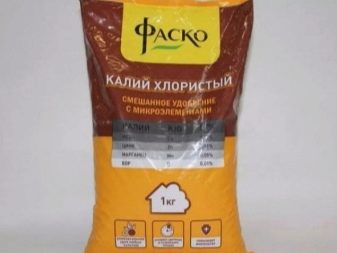
Rooting stimulants should be used without fail, the most effective of them are:
- Kornevin;
- "Kornerost";
- Charkor.
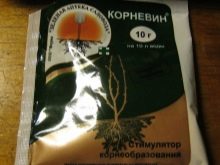
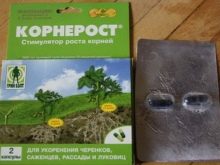
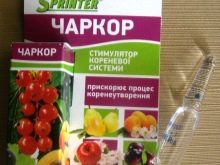
You can buy these drugs in a specialized store, they are in the form of a powder or liquid composition. It is forbidden to use liquid substances for layering.If the fertilizer is presented in the form of a thick gel, then they should cover the sprouts using a special brush.
Mineral formulations contain nitrogen as well as other components. The cutter directs all its vital resources to the formation of roots. It is permissible to introduce nitrogen only after the plant has completely taken root.
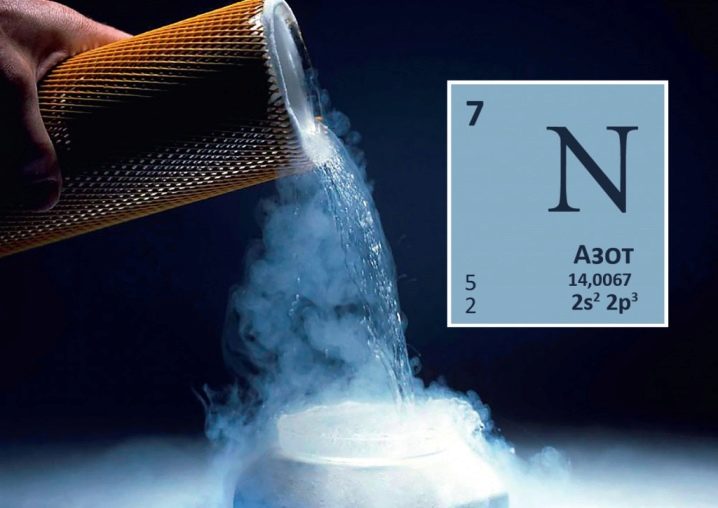
In time, this can take no more than one year, only after the end of such a period is it permissible to add nitrogen-containing compounds.
At certain periods of development, plants require growth stimulants. These funds activate the metabolism in the root system, but a measure is required in everything so as not to destroy the shoot. The sprouts should be soaked in a mixture of a certain consistency:
- "Heteroauxin";
- "Kornerost";
- Kornevin;
- "Succinic acid".
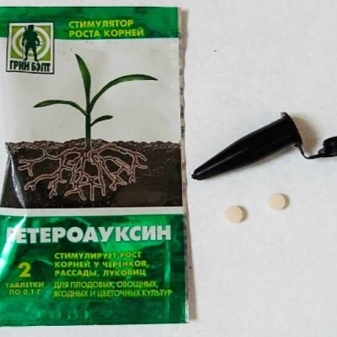
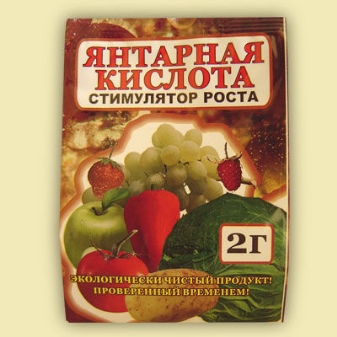
The solution should not get on the leaves during the soaking process. If the stem is too tough, it can be processed for up to 24 hours. On average, it takes no more than 8 hours in total.
One of the most useful stimulants is Radifarm, it is effective and contains additional trace elements. And also useful "Zircon" (14 drops per liter of water) - this is another effective tool.
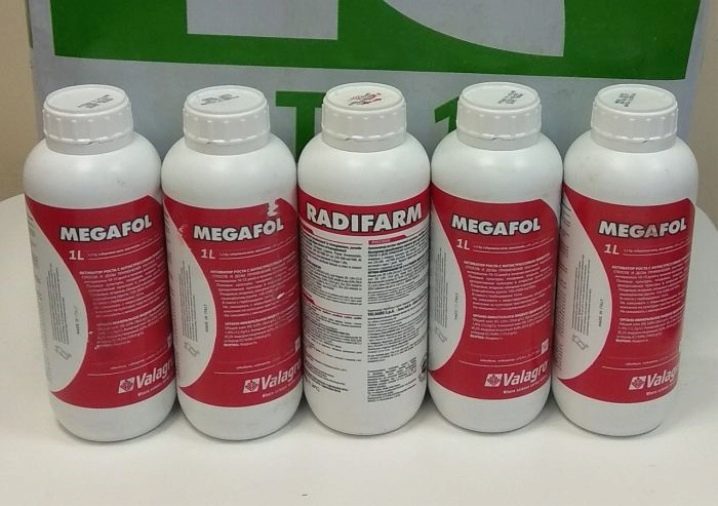
"Epin" is especially active in stimulating the development of roots (38 drops per liter of liquid). It usually takes 12-18 hours for the root system to "come to life", the metabolic rate doubles.
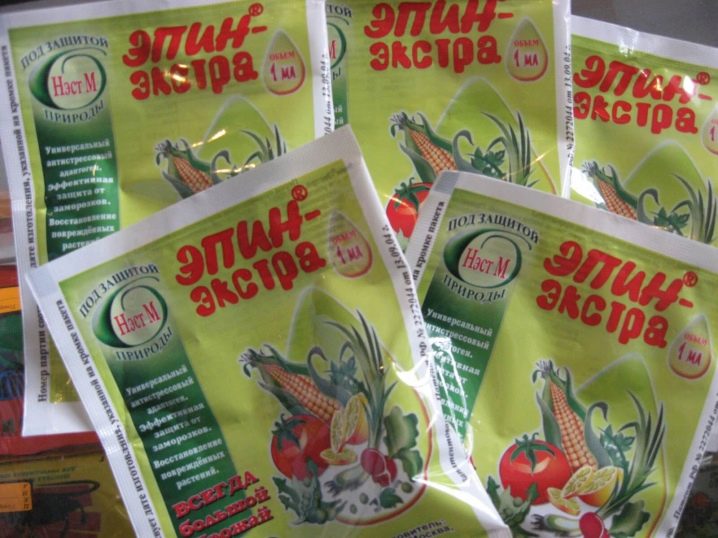
What are the best roses to grow from a cuttings:
- large-flowered variety "Flammentants";
- Iceberg and Rosalinda varieties from the floribunda group;
- tea-hybrid (these are far from tea, do not be confused).
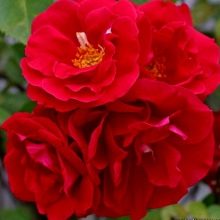

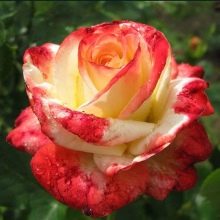
All of these varieties take root in a short time, but then the roots do not develop very actively, it is difficult to do without grafting. The grafting process is most difficult to apply to remontant and park roses.
Cutting takes place in this way: healthy shoots are selected, the thickness of which is about 5 millimeters. They are cut into small pieces, on which there should be several buds (up to five). In the upper part of the plant, the incisions are made straight, in the lower part they are made obliquely. All notches are made with tweezers or a sharp knife, the blade must be treated with alcohol.
The upper notch is left just above the kidney (2.5 cm), the lower cut is made below the outer kidney.
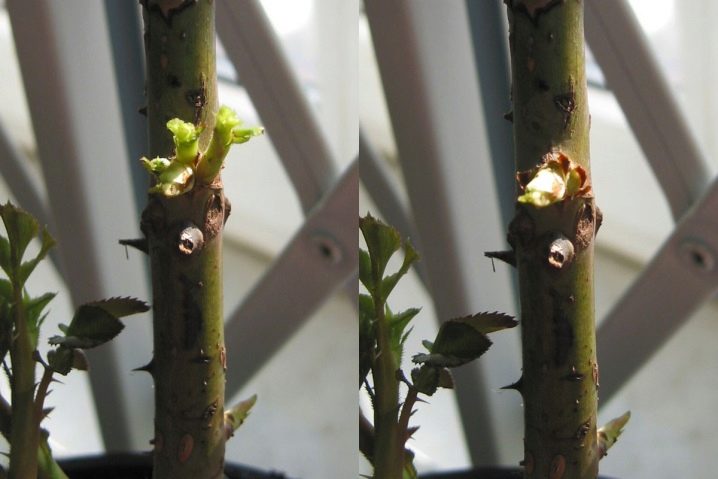
At the bottom, the leaves should be completely removed. Several leaves can be left on the sprout (2-3). Reproduction of the plant is carried out in September or October, during this period the seedling is exposed to less stress, it takes root more actively. The landing rules are as follows:
- cuttings are cut, treated with a special compound that stimulates root growth ("Heteroauxin");
- a small hole is dug, the depth of which is 25 cm, it is filled with grass by 2/3, then it is sprinkled with compost;
- shoots are planted with a slope of 40 degrees, a third of the plant with two buds remains above the ground;
- the shoot is watered abundantly.
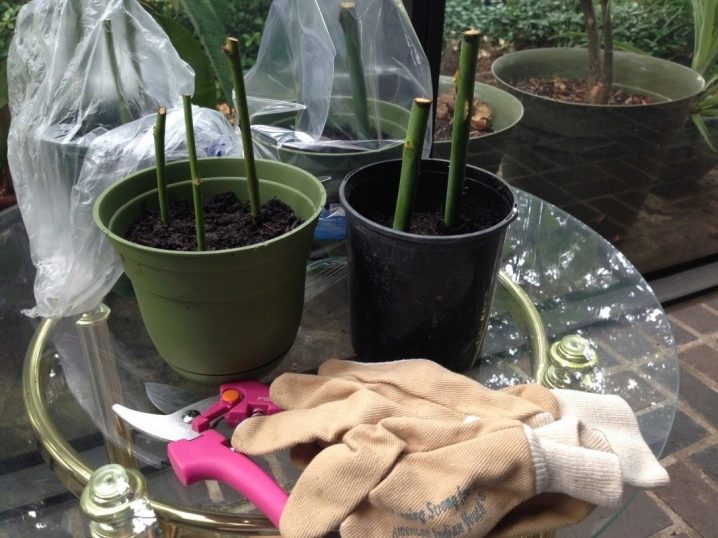
Some novice gardeners are not entirely aware of how to properly cover cuttings in cold weather. This is done in this way: an empty two-liter PVC bottle is taken, holes are made in it so that oxygen can flow. The bottle is covered with foliage and matter. The planting site is marked with wooden fragments, straw is spread.

A similar technology is applicable for private agricultural farms, for amateur gardeners and even for housewives who grow roses at home. Consists of the following items:
- plants with several swollen buds are harvested (their length is no more than 20 centimeters);
- so that the plants do not bloom earlier than planned, you can dip them in liquid wax, then pour cold water over them.
The cuttings are placed in a pot. A PVC container is taken, filled with fine gravel. A layer of 7 cm is enough. Then soil is poured on top, which is mixed with perlite. The soil must be moist.The stalk is dipped in water, poured with a special compound ("Kornevin"), and installed in the ground. On average, up to 35 cuttings can be installed in a container with a diameter of 45 cm. The bucket is wrapped with PVC film, fastened with paper clips (or clothespins). It is prohibited to store containers in direct sunlight. The container is wrapped in insulation and placed on the loggia, insulation is also placed below.

Keeping cuttings in cold weather is easy. This is done in this way: a hole is dug with a depth of 17 cm, its bottom is covered with cotton cloth, cuttings are placed on it. The edges are marked with pegs.
Preparing cuttings for conservation is a fairly simple procedure. The leaves are removed, the cuttings are laid out at the same distance, covered with earth. They can be removed in the spring. Those cuttings that "feel normal" have a small plant formation, callus, roots begin to grow on this "pimple". In the event that the planting is done after a certain amount of time (no more than two days), then the cuttings are placed in a container in which there is water. If possible, it is permissible to add a few drops of stimulating solution ("Epin").
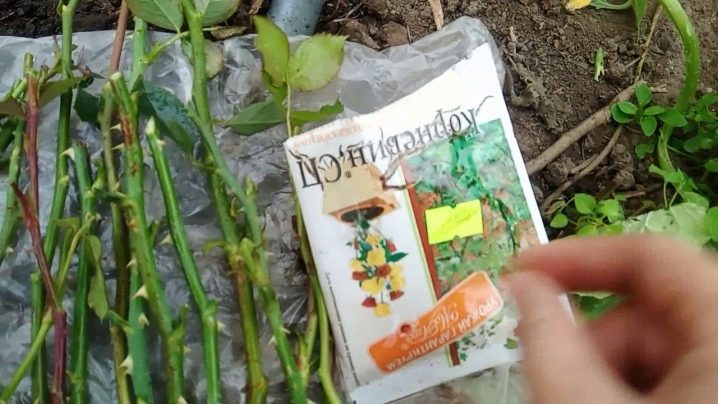
From folk remedies, it is best to use dried yeast. They contain a large number of useful elements (140 grams per liter of water). Seedlings are soaked for no more than a day.
Honey can also be effective (120 grams per liter of water). Honey is an excellent antiseptic and contains a group of B vitamins. Soak in a solution of honey for about 20 hours.
Willow water is made by infusing willow twigs from the shoots. Cuttings are soaked in liquid shortly before planting.
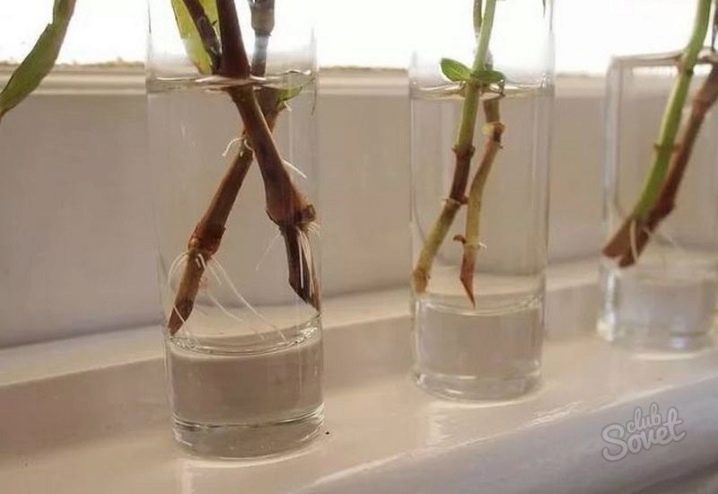
Burrito method
Burrito is a traditional Mexican dish, just like the Big Mac in the United States. The technology of propagation of a garden rose resembles in its structure the Mexican "pie".
Burrito is an unconventional way of propagating roses: cuttings are wrapped in wet newspaper or cotton rag. In form, it really resembles a dish in which the contents (the handle itself) are wrapped in the appropriate material. For the plant, this wrapping is a blessing. Inside there are excellent conditions for the beginning of the vegetative period of maturation of the root "knob", callus, due to which the root system will appear. If we draw an analogy with the human body, then this is similar to the formation of stem cells and the appearance of an embryo.
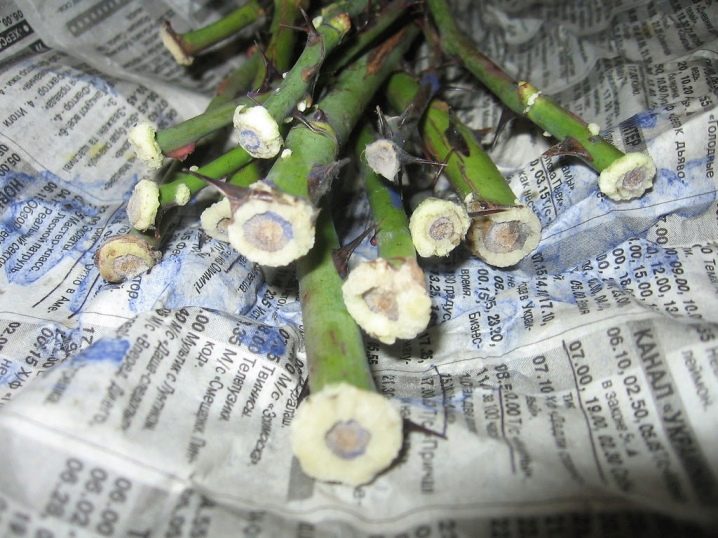
Layers are separated from the bush, carefully examined. A package is made of newspapers, cuttings are put into it (no more than 7 pieces). The newspaper is folded in 3-5 layers, doused with water. The bag can be wrapped in plastic.
It is permissible to store such packaging at a temperature of + 15-19 degrees; this is the optimal mode for the appearance of callus. After a couple of weeks, it is best to check the packages, sometimes rot or fungus forms on the plants, such specimens should be discarded. If necessary, soak the paper again with water.
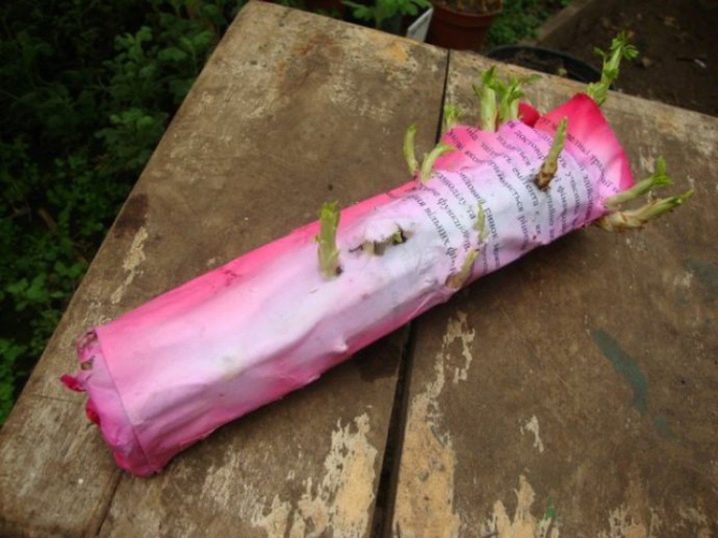
After callus formation, the cuttings are planted in the soil so that the upper bud is present above the surface. The soil should be moistened at an average level, the temperature for growth is +24 degrees.
The container with cuttings should be "ventilated" regularly, in no case should the soil be allowed to turn into a wet mud substance. But the opposite is also true: the drying out of the contents of the package leads to the death of the seedling.

In potatoes
Cuttings from rose branches can be rooted in potatoes. It is a favorable environment for plant propagation. A freshly cut sprout is processed with potassium permanganate, it can be left in aloe juice (the proportion is 1/1), it can stay there for no more than half a day.
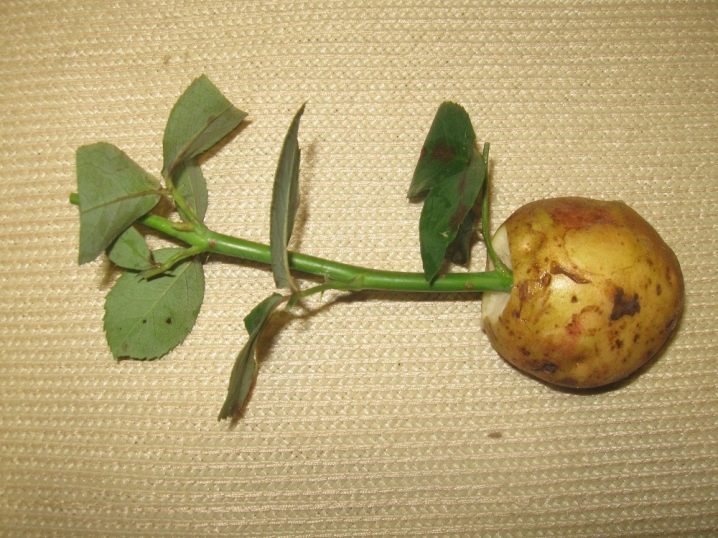
After that, the stalk of the future flower is inserted into the tuber, from which the "eyes" are cut.Such "ikebana" is placed in a container, sprinkled with earth (2/3), watered with a solution of potassium permanganate (a fairly dark concentration is needed). Before watering, the water must settle (8 hours). Add water with a little sugar dissolved in it once a week (a couple of teaspoons per glass of water).
From a bouquet
The life of a bouquet of roses can be extended for quite a long time if they are cut into small pieces and soaked for one day in water. Almost any variety can be cut by dividing. The stems are cut into small pieces, they can be rooted in containers that are filled with peat or soil. Aloe solution (1/10) is often made and added to the planted plant. Cuttings love high humidity and temperature; under such circumstances, the root system will form quickly.
Sometimes pruning should be done so that the vital resources of plants are distributed more rationally.
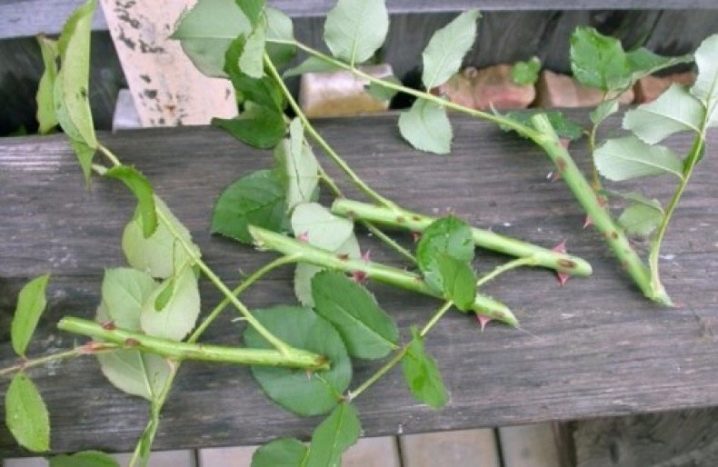
When planting, close attention should be focused on the stems. They must be flexible, this indicator confirms their "liveliness". If the stems are "stone", tough, then the probability of their germination is sharply reduced.
If the roses are brought from Holland or Poland, the operation of growing a flower from the stem will not work; in these countries, flowers are abundantly watered with chemicals (stabilizers, preservatives).
Landing rules
Rose is a rather capricious plant, it requires attention and maintaining temperature and other conditions. Loves very lighted places, direct sunlight. It is important to observe the correct humidity regime, many questions often arise here. Too wet soil leads to decay of the root system, too dry soil inhibits vegetative development.
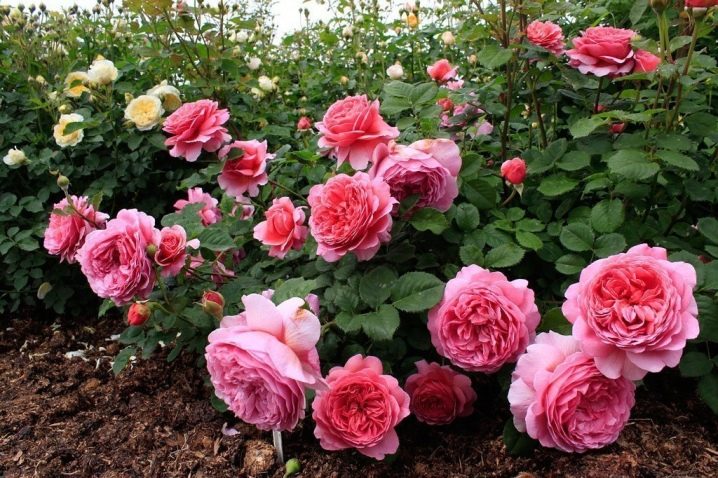
Roses that are grafted onto rose hips stand out for their good resistance. Loam is most suitable for roses, the acid-base pH is 6.7-7.3. There must be good air exchange in the soil. Soil, which contains a lot of sand, is also suitable for growing a rose. Such soil should be properly fertilized, and other soils should be added. The soil, in which there is a lot of humus, is always moist, but, on the other hand, the air exchange in it is not as active as in the sand. Often, such soil is sprinkled with a layer of river sand, then dug up after a while.
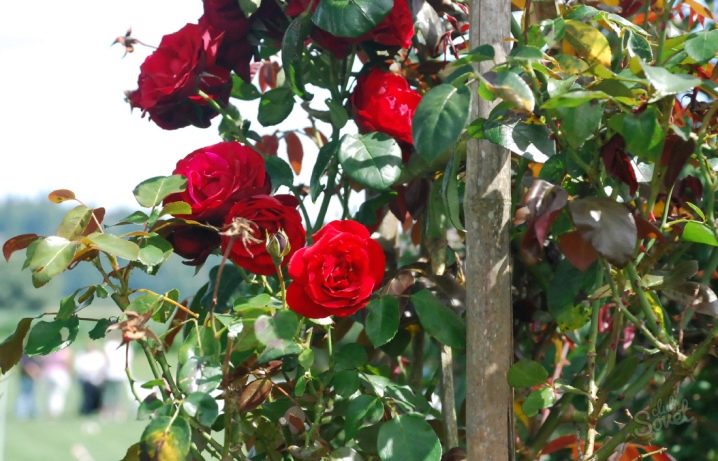
Something similar can be said about earth rich in clay - such earth sticks together when there is a lot of moisture and does not allow oxygen to pass through. In the hot season, it quickly cracks. In this case, a certain amount of fine sand should also be added.
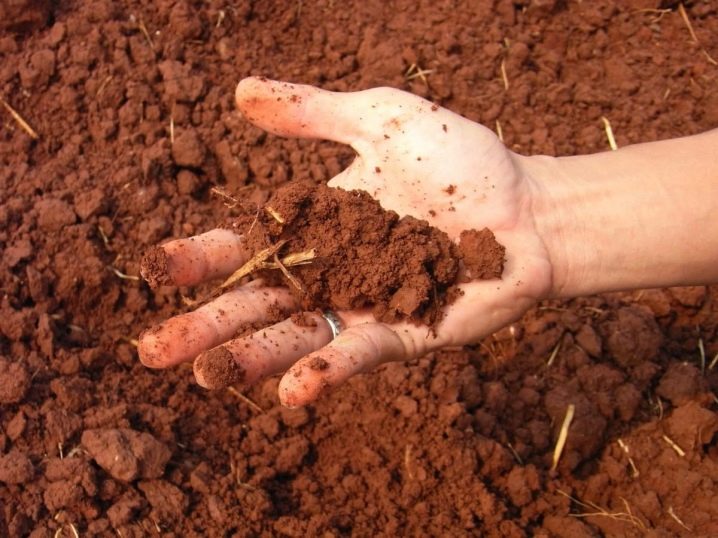
Detailed instructions on how to properly plant plants of the family of bush roses:
- before planting, it is required to dig a hole with a depth of at least half a meter;
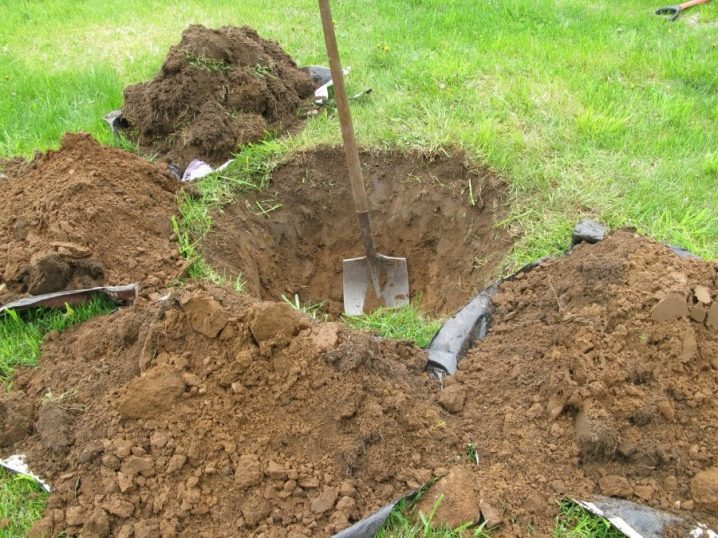
- the seedling is removed from the package, carefully inspected for defects;
- then he is immersed in a container of water;

- if there are damaged fragments on the plant, they must be carefully cut off;
- fertilizers are prepared and mixed with the substrate;
- an "Initiator" tablet is placed at the bottom of the hole, which will be a good remedy against the effects of various parasites - usually the action of such a drug is enough for 1 year;
- the seedling is installed in the hole, while the root system is gently straightened;
- the root base (with the point where the grafting takes place) should be 5 centimeters in the ground, which will not allow the rosehip stock to bloom.
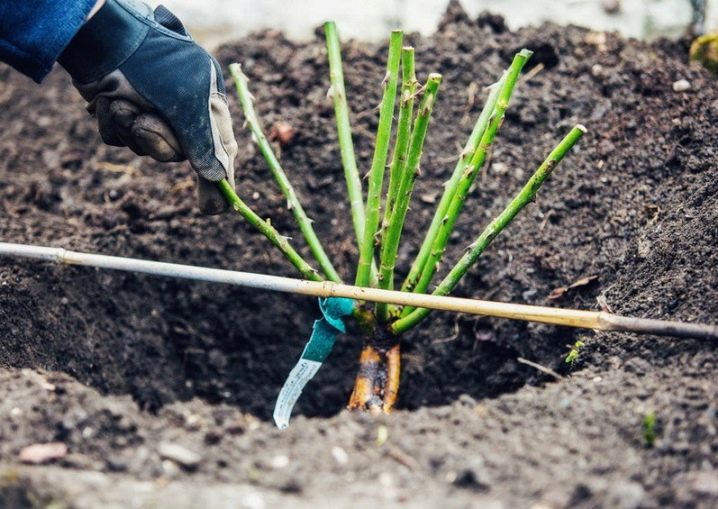
Care Tips
Experts willingly share their secrets and give a lot of useful advice to novice gardeners. Here is some of them.
- Roses thrive in areas sheltered from the winds that are well lit.

- Groundwater should be 1.2 meters from the surface. It is important that the root system is in a humid environment, but if the percentage of humidity is too high, the plant may die.
- Do not plant roses in wetlands.
- It is not recommended to cut the cuttings with scissors; if there are “scuffs” or burrs, the plant will die.
- To organize the reproduction of a plant in the cold season (autumn), it is best to choose sprouts with a "knob", which is formed from the old material. Callus forms on it, and the future root system sprouts.
- When planting in autumn, be sure to leave a couple of leaves at the top of the plant.
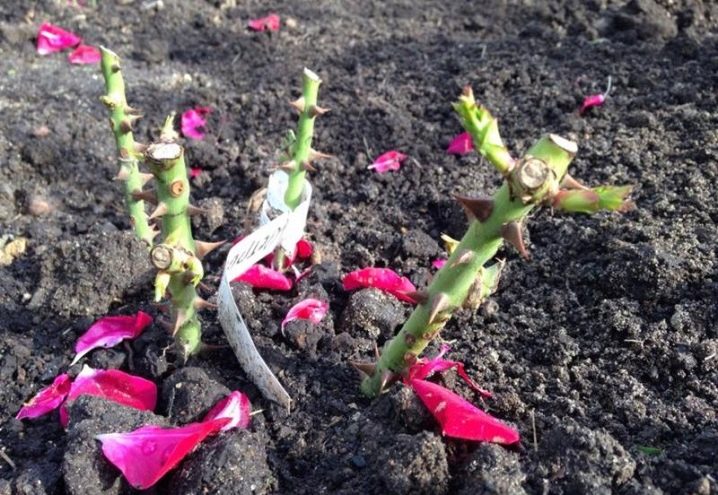
- Sometimes, so that the buds do not bloom unpredictably, it is better to dip the plant in hot wax and then pour it over with cold water.
- To get up to five plants, you should plant up to a dozen cuttings.
- It is better to use a container for planting in a small container (up to 1 liter), it is best to use glass or transparent PVC so that you can see how much the root system has sprouted.
- Almost any primer suitable for flowers is suitable.
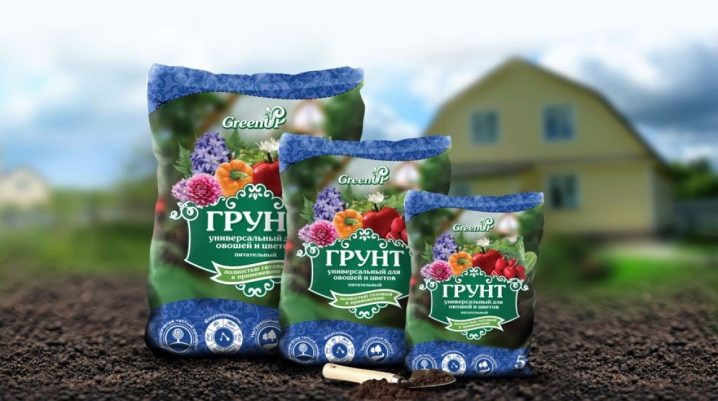
- Sometimes river sand (1/2) is added, sand allows moisture to penetrate better. And also perlite and vermiculite are added as a nutritional supplement.
- If it is possible to add sphagnum moss, the plant will grow even better. This product provides optimal soil ventilation and improves the growing environment.
- Before planting, you can disinfect the soil with a weak solution of potassium permanganate.
- Sometimes it is useful to germinate cuttings in water, then the chance of their more reliable rooting increases.
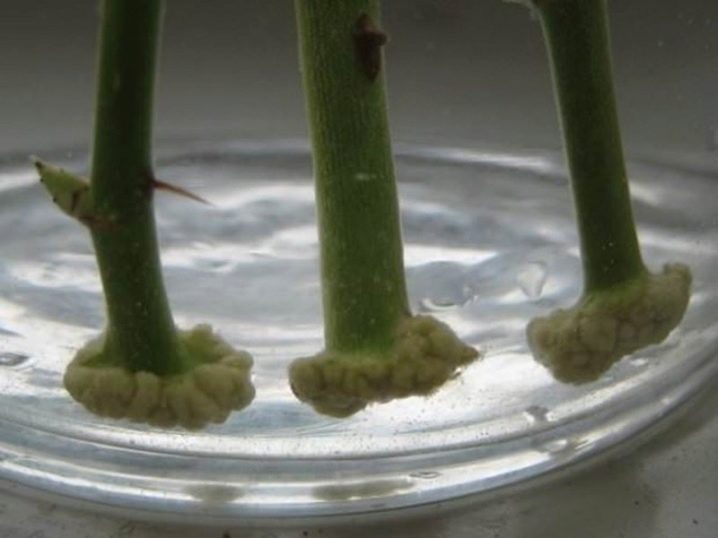
- Plants that have roots (at least 1 centimeter in length) can be germinated in water. So that the cuttings are not seduced, you can add a little "Fitosporin" to the water.
- A layer of peat (25 cm) helps well in warming plants, it also helps to absorb moisture and retain it.
- When planting, the distance between plants should be no more than 95 cm. Such species as polyanthus, hybrid tea, floribunda can be planted at a distance of up to 65 cm. Climbing and standard varieties are planted at a distance of up to 1 meter.
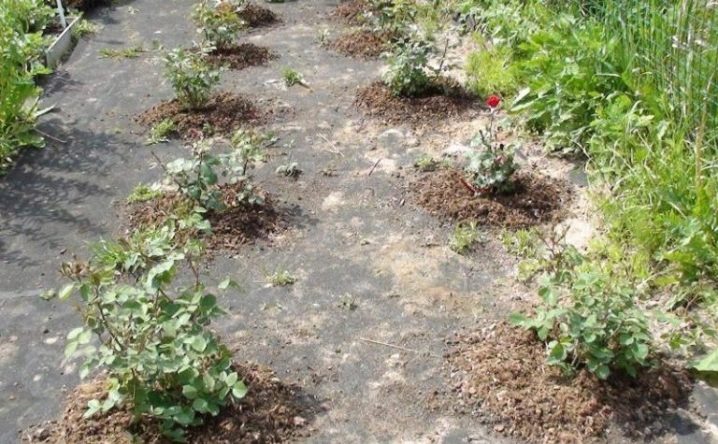
- If you grow seedlings on a windowsill, then it is best on the east side, so that the scattered rays of the sun fall.
- It is advisable to air the seedlings every day.
- Watering should be selected individually, in this matter there can be no hard recipes.
- It is not difficult to root the cutting on the windowsill, it is only important to monitor the moisture level and temperature of the windowsill itself.

Reproduction of roses by the "Burrito" method, see the video below.

































































































The comment was sent successfully.